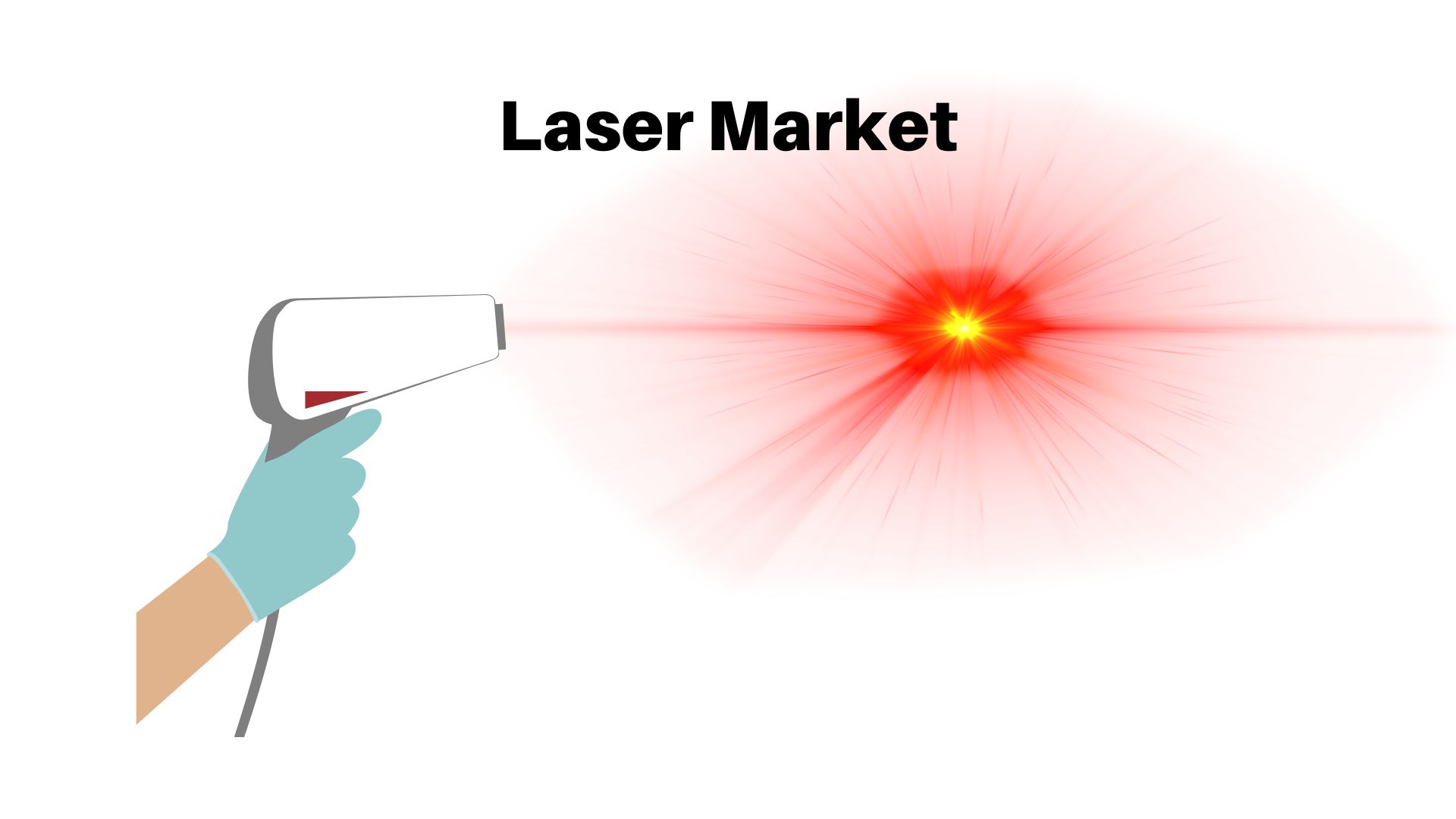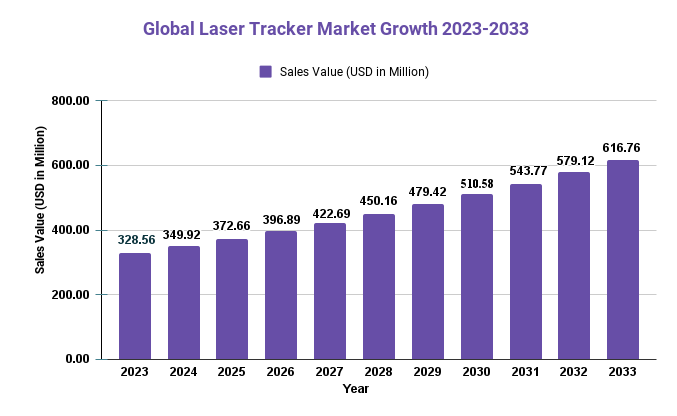Laser Tracker Market is projected to reach USD 579.12 Million by 2032

Page Contents
Market Overview
Published Via 11Press: The global laser tracker market was valued at approximately USD 308.51 million in 2022 and is projected to reach USD 579.12 million by 2032, growing at an annual compound growth rate (CAGR) of 6.5% during this forecast period.
Laser trackers are precision measuring instruments used to accurately measure large objects such as aerospace components, automotive parts, and heavy machinery. These devices use laser beams to follow the motion of a retroreflector placed on the object being measured, providing highly accurate readings.
The laser tracker market is being propelled forward by several factors, including an increasing need for high-precision measurement tools in industries such as aerospace and automotive; automation and digitization in manufacturing; and rising adoption of laser trackers in emerging markets such as Asia-Pacific.
Want to Access the Statistical Data and Graphs, Key Player's Strategies| https://market.us/report/laser-tracker-market/request-sample
Key Takeaway:
- A growing market for accurate measurement instruments: There is an increasing demand for laser trackers in aerospace, automotive, heavy machinery, and other industries. Laser trackers provide superior accuracy in measuring large objects making them indispensable tools in industrial settings and manufacturing processes.
- Automation and Digitization are growing trends. Laser trackers are needed to keep up with the increasing demand for automation and digitization. Laser trackers can be incorporated with other technologies like robotics or computer-aided development (CAD), to speed up measurement and improve efficiency.
- Adoption in Emerging Markets is Growing: Laser trackers have been growing in popularity in emerging countries like Asia-Pacific due to the rising need for precise measurement tools and industrialization.

Regional Snapshot:
- North America: North America represents a significant market in laser trackers. It is home to key players like FARO Technologies Inc. and Hexagon AB. There is also a growing demand for high-precision measurement tools in industries like aerospace and automotive. The United States accounts for most of the revenue share and is the largest market.
- Europe: Europe represents another major market for laser tracking devices due to key players such as Leica Geosystems AG or API Technologies Corp. as well as the increasing demand for high-precision measurement equipment in sectors such as electronics, aerospace, automotive, and electronics. The region's largest markets are Germany and Great Britain.
- Asia-Pacific: Asia-Pacific is an area where laser trackers are rapidly growing. This is due to both increased industrialization and the rising demand for high-precision measurement tools. China, Japan, India, and India are the major markets in this region. For key market players, the region offers significant growth opportunities.
- Rest of the World. This includes Latin America (the Middle East) and Africa. Due to increasing demand in emerging markets for laser trackers, as well as the growing acceptance of automation in manufacturing processes and digitization, the region is expected to show moderate growth.
Drivers
- Increased Need for Accurate Measurement Tools: High-precision measurement tools are becoming more and more essential in industries like aerospace, automotive, and heavy machinery. Laser trackers offer excellent accuracy when measuring large objects – making them indispensable tools in industrial processes.
- Adoption of Automation and Digitization: The trend towards automation and digitization in manufacturing is driving demand for laser trackers. Laser trackers can be integrated with other technologies like robotics or CAD software to streamline measurement processes and boost efficiency.
- Laser tracker adoption is on the rise in emerging markets such as Asia-Pacific, due to expanding industrialization and the need for high-precision measurement tools.
- Advancements in Technology: The laser tracker market is being driven by advances in technology, such as portable and handheld laser trackers that offer greater flexibility and ease of use. These advancements are anticipated to spur laser tracker adoption across various industries.
Restraints
- High Cost: Laser trackers tend to be expensive compared to other measurement tools, such as coordinate measuring machines (CMMs). The high price can be an impediment to adoption for small and medium-sized enterprises (SMEs).
- Laser trackers have limited applications: Laser trackers are typically used for measuring large objects or surfaces and cannot accurately measure small or intricate parts. This limitation can pose a challenge in the market.
- Complex setup and operation: Laser trackers require specialized training to operate, making their setup relatively complex. This complexity could pose a hurdle to adoption for companies without enough experienced personnel.
- Alternative Measurement Tools: Other measurement tools, such as CMMs and optical trackers, offer similar accuracy at lower costs. These alternatives could prove a deterrent for the laser tracker market.
- Impact of COVID-19: The COVID-19 pandemic has had a devastating effect on the global economy, potentially impacting the laser tracker market as well. Disruptions to supply chains, reduced demand, cancellation, or delay of projects have all had an adverse effect and could potentially create obstacles for growth in this space.
Make an inquiry before buying this report @ https://market.us/report/laser-tracker-market/#inquiry
Opportunities
- Emerging applications: Laser trackers are being used in new and emerging applications, such as 3D printing and additive manufacturing, which present significant growth opportunities for the market.
- Growing demand in emerging markets: Emerging markets such as Asia-Pacific and Latin America are experiencing significant industrialization, and this presents a significant growth opportunity for the laser tracker market. The increasing demand for high-precision measurement tools in these regions is expected to drive the adoption of laser trackers.
- Advancements in technology: Technological advancements, such as the development of portable and handheld laser trackers, are expected to drive the adoption of laser trackers in various industries. New and innovative products that offer greater accuracy, ease of use, and portability present significant growth opportunities for the market.
- Integration with other technologies: Laser trackers can be integrated with other technologies, such as CAD software and robotics, to automate measurement processes and improve efficiency. This presents a significant growth opportunity for the market.
- Use in non-industrial applications: Laser trackers are also used in non-industrial applications, such as surveying, architecture, and heritage preservation. The use of laser trackers in these applications presents significant growth opportunities for the market.
Challenges
- Intense Competition: The laser tracker market is highly competitive, with numerous players offering similar products. This intense competition presents companies with the challenge of differentiating their goods and services in order to remain viable competitors.
- Customer Needs Evolution: Customers' demands and requirements are ever-changing, necessitating companies in the laser tracker market to adjust quickly in order to stay ahead of competitors. Failure to do so could result in missed opportunities and a decline in market share.
- Integration Challenges: Integrating laser trackers with other technologies, such as CAD software or robotics, can present some unique challenges. Companies must guarantee their products are compatible with these platforms and offer adequate training and support to guarantee successful integration.
- Regulatory Challenges: Companies operating in the laser tracker market must abide by various regulations, such as safety and environmental requirements. Failure to abide by these rules could have legal and financial repercussions.
- Impact of Economic Downturns: The laser tracker market can be particularly vulnerable to economic downturns, as companies may reduce spending on high-end measurement tools during difficult economic periods. The potential repercussions for companies operating in this space can be immense.
Recent Developments
- Introduction of New Products: Companies have recently unveiled laser tracker products such as the FARO VantageS6 and Leica Absolute Tracker AT960-SR. These devices boast advances in technology like improved accuracy and portability, which are expected to drive growth within the market.
- Strategic Partnerships and Collaborations: Companies in the laser tracker market have formed strategic partnerships and collaborations to expand their product offerings and reach new customers. For instance, FARO Technologies joined forces with ATS Global to offer automation solutions for manufacturers.
Key Market Segments
Type
- Measured Radius <50m
- Measured Radius 50-80m
- Measured Radius >80m
Application
- Automotive
- Aerospace & Defense
- Energy & Power
- General Manufacturing
- Architecture & Construction
- Transportation
- Others
Key Market Players included in the report:
- Hexagon
- Faro
- API
- SGS
- VMT
- On-Trak Photonics
- Variation Reduction Solutions
- Brunson
- Hubbs
- PLX
- Verisurf
- Oasis Alignment Services#LLC
- Nebula3D Services Private Limited
- Mactech Inc.
- East Coast Metrology#LLC
Report Scope
| Report Attribute | Details |
| The market size value in 2022 | USD 308.51 Bn |
| Revenue Forecast by 2032 | USD 579.12 Bn |
| Growth Rate | CAGR Of 6.5% |
| Regions Covered | North America, Europe, Asia Pacific, Latin America, and Middle East & Africa, and Rest of the World |
| Historical Years | 2017-2022 |
| Base Year | 2022 |
| Estimated Year | 2023 |
| Short-Term Projection Year | 2028 |
| Long-Term Projected Year | 2032 |
Frequently Asked Questions
Q: What is the expected growth rate for the laser tracker market?
A: The laser tracker market is expected to grow at a CAGR of around 6.5% from 2022 to 2032.
Q: What is a laser tracker?
A: A laser tracker is a high-precision measuring instrument used to determine the position and orientation of objects in three-dimensional space.
Q: What are the benefits of using a laser tracker?
A: Laser trackers offer numerous benefits, such as high accuracy, fast measurement speeds, and the ability to measure large objects or areas.
Q: What are the key players in the laser tracker market?
A: Some of the key players in the laser tracker market include Hexagon, Faro, API, SGS, VMT, On-Trak Photonics, Variation Reduction Solutions, Brunson, Hubbs, PLX, Verisurf, Oasis Alignment Services#LLC, Nebula3D Services Private Limited, Mactech Inc., East Coast Metrology#LLC.
The team behind market.us, marketresearch.biz, market.biz and more. Our purpose is to keep our customers ahead of the game with regard to the markets. They may fluctuate up or down, but we will help you to stay ahead of the curve in these market fluctuations. Our consistent growth and ability to deliver in-depth analyses and market insight has engaged genuine market players. They have faith in us to offer the data and information they require to make balanced and decisive marketing decisions.



